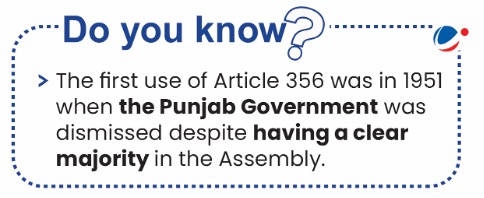Why in the news?
S.R. Bommai's judgement (1994) of the Supreme Court (SC) completes 30 years.
About S. R. Bommai (SRB) v. Union of India (UOI),1994 Judgment
- In 1989, the Central government dismissed SRB’s government in Karnataka under Article 356 of the Constitution and President’s Rule was imposed.
- A nine-judge bench of the SC interpreted Article 356 of the Constitution to define the contours of the proclamation of President’s rule.

About Article 356
|
Key Questions in SRB’s Case
- One, whether proclamations of the President’s Rule were justiciable (liable to judicial review court).
- Two, the scope and limits of the President’s powers under Article 356.
- The Constitution is silent on what constitutes a failure of constitutional machinery making the provision vulnerable to misuse.
- Three, what are the consequences if the Court hold the proclamation of the President’s Rule invalid even after Parliament has given its approval.
Bommai judgement and Key Principles laid down:
- Judicial Review: SC declared, presidential proclamation under Article 356 is subject to judicial review on substantial grounds.
- No restriction on the court from examining the material based on which the President formed his satisfaction.
- SC or HC can strike down the Proclamation if it is mala fide or based on wholly irrelevant or extraneous grounds.
- Limits of the President’s powers: The verdict concluded that the power of the President to dismiss a state government is not absolute. The president should exercise the power only after his proclamation is approved by both Houses of Parliament.
- Till then the President can only suspend the Legislative Assembly by suspending the provisions of the Constitution relating to the Legislative Assembly.
- Consequences of invalidation of President’s Rule:
- Both the Council of Ministers and the Legislative Assembly should stand restored.
- The validity of the acts done, orders passed and laws, made during the period of operation of the proclamation would remain un-effected.
- Other key observations:
- Laid down the supremacy of the floor test in determining the support enjoyed by the party in power.
- The use of Article 356 was justified only when there was a breakdown of constitutional machinery and not that of administrative machinery.
- Based on the Sarkaria Commission report (1988), the SC in this case has enlisted where the use of the exercise of power under Article 356 could be proper or improper.
- Proper use example: constitutional direction of the Central government is disregarded by the state govt (Art 365).
- Improper use example: State govt is not given prior warning to rectify itself except in case of extreme urgency leading to disastrous consequence.
- Secularism, democracy and federalism are the essential features of our Constitution and are part of its basic structure.
- An attempt was made to define secularism: it is more than a passive attitude of religious tolerance. It is a positive concept of equal treatment of all religions.
Impact of S.R. Bommai Judgment
- Restrictive use of Article 356: Between January 1950 and March 1994, the President’s Rule was imposed 100 times or an average of 2.5 times a year. Between 1995 and 2021, it has been imposed only 29 times or a little more than once a year.
- Strengthen Federalism: The judgment made Article 356 proclamations justiciable without undermining the President’s discretionary powers, thus strengthening India’s federalism without diminishing its separation of powers.
Conclusion
Post-1994, the Bommai case was cited several times, making it one of the most quoted verdicts in the country's political history. As India continues to navigate the complex dynamics of centre-state relations and the role of secularism in governance, the principles established in the S.R. Bommai case remain vital in upholding the constitutional ideals of federalism and pluralism.



